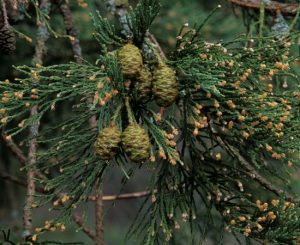Sequoiadendron giganteum
Giant Sequoia trees are the largest growing tree varieties of all trees. They can easily reach a height of 300 feet. They are commonly called as redwoods. They are non-flowering conifer trees that prefer to grow in colder climates!
Taxonomy
| Kingdom: | Plantae |
| Division: | Pinophyta |
| Class: | Pinopsida |
| Order: | Pinales |
| Family: | Cupressaceae |
| Subfamily: | Sequoioideae |
| Genus: | Sequoiadendron |
| Species: | S. giganteum |
Anatomy
The Sequoia trees will have a red bark (Trunk) as the name suggests “Redwoods”! Their leaves are needle like and these trees are conifers. Moreover, the Giant Sequoias are evergreen i.e., they bear their needles all the year long. This is an image of the foliage of the Giant Sequoia. Look for Narrow, grey-green, flat, lance-like leaves with prickly ends, forming round, rope-like foliage sprays of short, overlapping scale-like needles. Opposite or alternate arrangement. The leaves would be sometimes grey on the rear-side.
These Giants reproduce by producing male and female cones as seen in the image on the right. The male cones are smaller and produce pollen and disperse them in air. The female cones are larger and are formed at the ends of the needles. They get fertilised and the seeds get matured inside. As the seeds mature, the cones dry and open up to release the seeds which grow into new trees!

Occurrence
Redwoods like the Sequoia are native to Western Sierra Nevada, California, United States. These trees grow naturally here and had been doing this for several thousands of years. They grow well in cooler climates. They grow well here as the winters are snowy and the summers are dry. The Giants also seem to like the foggy climate as it brings more moisture. They grow and survive to their fullest in places with such climatic conditions. They also survive in a very few other places but not to their fullest!
They occur in scattered groves, with a total of 68 groves, comprising a total area of only 144.16 km2 (35,620 acres). Nowhere does it grow in pure stands, although in a few small areas, stands do approach a pure condition. The northern two-thirds of its range, from the American River in Placer County southward to the Kings River, has only eight disjunct groves. The remaining southern groves are concentrated between the Kings River and the Deer Creek Grove in southern Tulare County. Groves range in size from 12.4 km2 (3,100 acres) with 20,000 mature trees, to small groves with only six living trees. Many are protected in Sequoia and Kings Canyon National Parks. –Wikipedia.
Over Exploitation
These trees were discovered by the Europeans in 1839 and they called these trees “Mammoth trees” and had realised the value of its Timber! They started to play havoc on these poor trees and cut down most of them just for Timber! Now, these trees are near the verge of extinction and are severely protected. Despite of the protection, these trees still face high mortality due to drought in California, competition from other conifers, etc.


The images are from Google which shows how severe was the logging back those days.
You can read about this further in the following websites, Monumental Trees and National Park Service.
General Sherman Tree
General Sherman is a Giant Sequoia tree located in the Giant Forest of Sequoia National Park in Tulare County, in the U.S. state of California. By volume, it is the largest known living single stem tree on Earth.
You can view this YouTube video to know the real size of this tree! One true Giant!

the two that climbed Sherman’s base roots should be found and charged